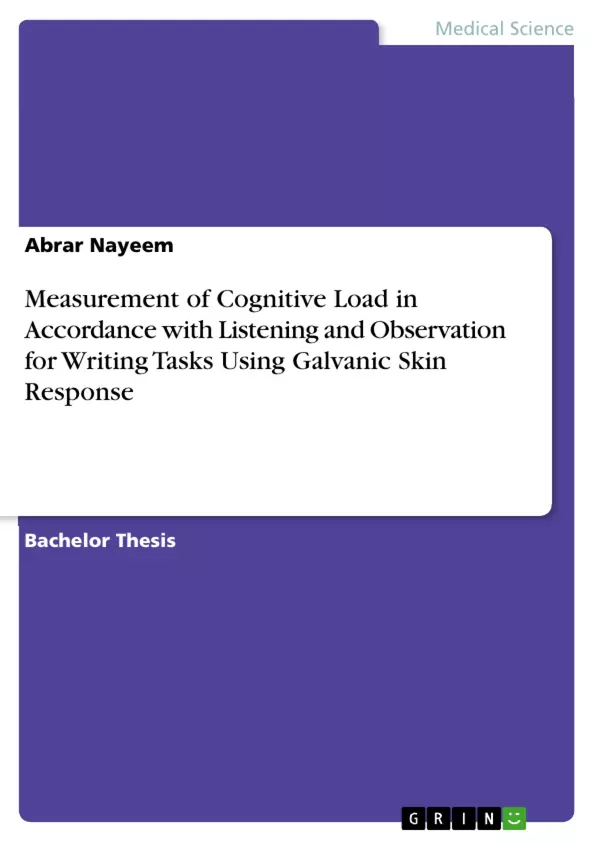The galvanic skin response alludes to changes in perspiration organ movement that are intelligent of the power of our passionate state, also called enthusiastic excitement. it has normally been explored through single or few measures and in one exploratory situation. Galvanic Skin Response (GSR) has as of late stood out for researchers as a planned physiological marker of intellectual feelings. In this exploration, intending to play out a far reaching study, we have evaluated GSR information capture for fifteen writing task and three difficulty levels and determined time and frequency domain feature. We determined that cognitive load is proportional to the task difficulty level. If cognitive load increases, task difficulty level will increase. If cognitive load decreases, task difficulty level will decrease.
Inhaltsverzeichnis (Table of Contents)
- Chapter 1. Introduction
- 1.1 Introduction
- 1.3 Objectives
- 1.3 Back Ground of this Thesis
- 1.4 Motivation
- 1.5 Thesis Layout
- Chapter 2. Literature Review
- 2.1 Literature Review
- Chapter 3. Cognitive Load
- 3.1 Introduction
- 3.2 Types of Cognitive load
- 3.2.1. Intrinsic load
- 3.2.2. Extraneous load
- 3.2.3. Germane Load
- Chapter 4. Galvanic Skin Response
- 4.1 Introduction
- 4.2 The Background of GSR signals
- 4.3 GSR signals explained
- Chapter 5. Data Collection
- 5.1. Task Description
- 5.2. Apparatus
- 5..3. QS222 GSR Sensor
- 5.4. Labquest Mini
- 5.5 Logger Pro Software
- Chapter 6. Process of GSR Analysis
- 6.2. Simulation Example 01
- 6.3. Simulation Example 02
- 6.4. Time domain feature
- 6.5 Frequency domain features
- Chapter 7. Analysis of Variance Test
- 7.1 Introduction
- 7.2 Types of Tests
- 7.2.1 One Way ANOVA
- 7.2.2 Two Way ANOVA
- 7.3 ANOVA vs. T Test
- 7.4 Alpha Level
- 7.5 P-Value
- 7.6 Difference between an alpha level and a p-value
- Chapter 8. Experimental Results & Discussion
- 8.1 Introduction
- 8.2 For time domain
- 8.3 For frequency Domain
Zielsetzung und Themenschwerpunkte (Objectives and Key Themes)
This thesis investigates the measurement of cognitive load during writing tasks using galvanic skin response (GSR). The study aims to understand the relationship between GSR signals and cognitive load, particularly for writing tasks.
- Cognitive load and its types (intrinsic, extraneous, and germane load)
- Galvanic skin response (GSR) and its application in cognitive load measurement
- Data collection and analysis methods using GSR sensors
- Interpretation of GSR signals and their correlation with cognitive load
- Experimental results and discussion of findings
Zusammenfassung der Kapitel (Chapter Summaries)
Chapter 1 introduces the research topic, outlining the objectives, background, motivation, and thesis layout. Chapter 2 provides a comprehensive literature review on cognitive load and GSR, exploring previous research and findings in the field. Chapter 3 focuses on the concept of cognitive load, explaining its different types and their relevance to learning and task performance. Chapter 4 delves into the principles of galvanic skin response, its physiological mechanisms, and its application in cognitive load assessment. Chapter 5 describes the data collection process, including the tasks used, apparatus employed, and software used for data acquisition. Chapter 6 details the analysis of GSR data, outlining the methods used to extract relevant features from the signals and interpret their significance. Chapter 7 explores the use of analysis of variance (ANOVA) tests for examining the relationship between cognitive load and GSR data. Chapter 8 presents the experimental results and discussion of findings, analyzing the data and drawing conclusions from the study. The chapter focuses on the relationship between cognitive load and GSR, considering both time and frequency domain features.
Schlüsselwörter (Keywords)
The research focuses on cognitive load, galvanic skin response, writing tasks, data analysis, ANOVA tests, time domain features, and frequency domain features. The study explores the use of GSR as a measure of cognitive load during writing tasks, investigating the relationship between GSR signals and cognitive load. The research utilizes ANOVA tests to analyze the data and draw conclusions about the findings.
- Arbeit zitieren
- Abrar Nayeem (Autor:in), 2019, Measurement of Cognitive Load in Accordance with Listening and Observation for Writing Tasks Using Galvanic Skin Response, München, GRIN Verlag, https://www.grin.com/document/509821



